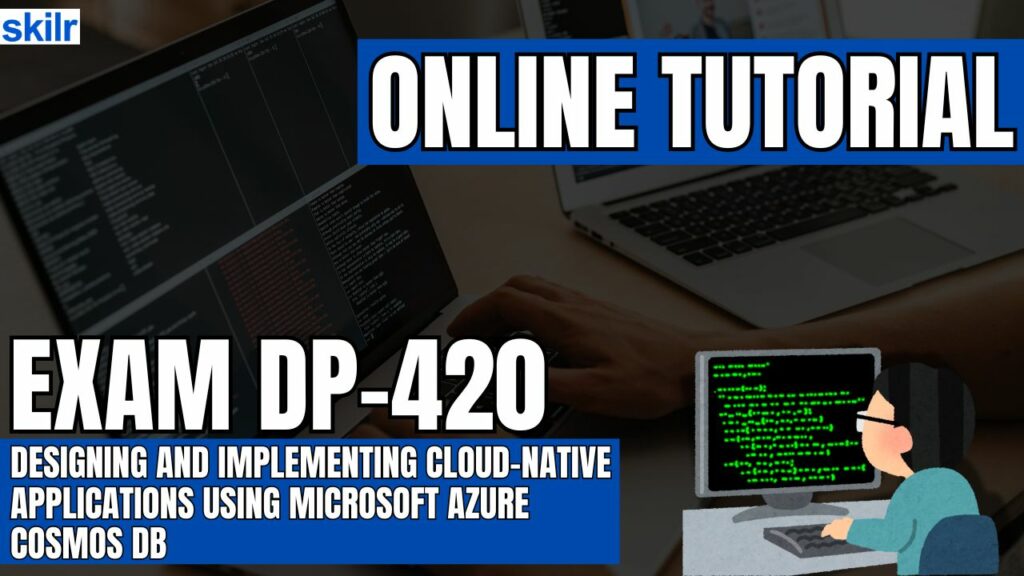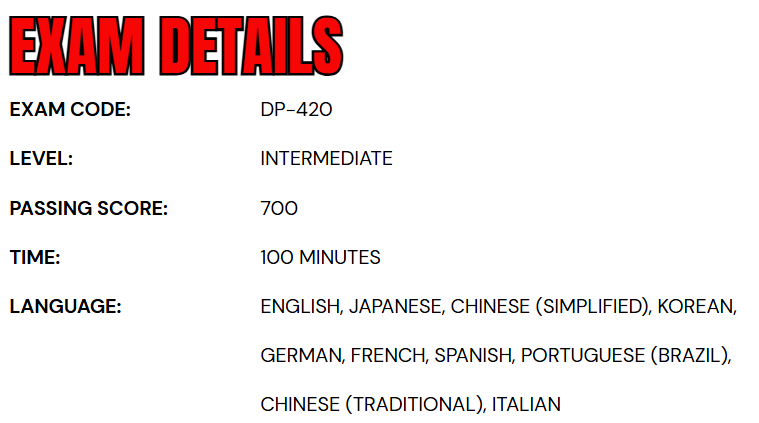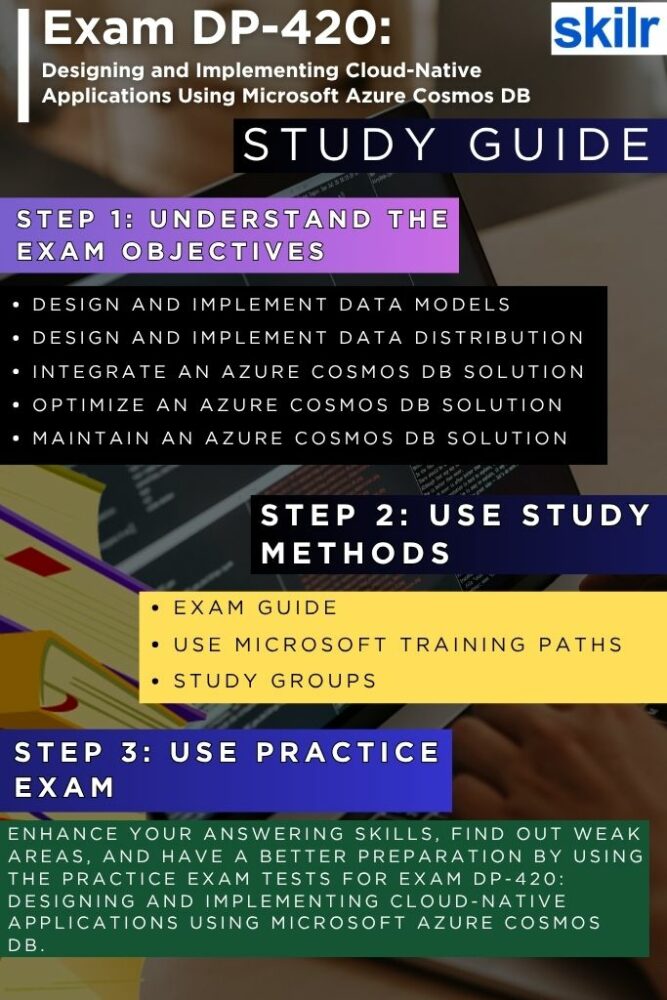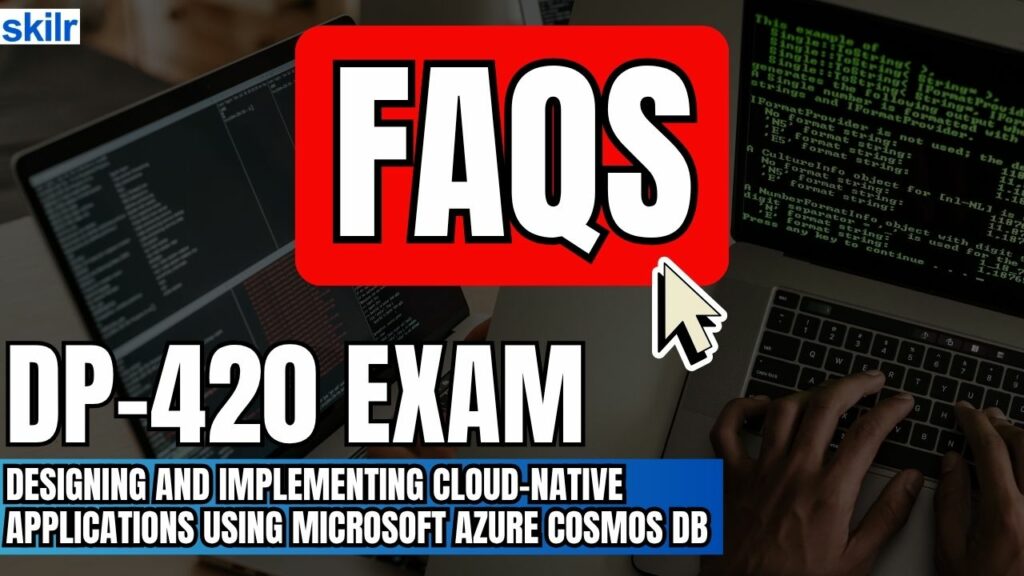
The DP-420: Designing and Implementing Cloud-Native Applications Using Microsoft Azure Cosmos DB certification is tailored for individuals with expertise in developing, deploying, and maintaining cloud-native applications that leverage Azure Cosmos DB for data storage and management.
– Role Responsibilities
Professionals aiming for this certification are expected to:
- Design and implement data models suited for distributed systems.
- Load and manage data efficiently within Azure Cosmos DB.
- Optimize, maintain, and monitor application performance.
In this role, you will also be responsible for integrating Azure Cosmos DB with other Azure services while ensuring that your solutions are designed with security, scalability, high availability, and resilience in mind.
– Required Skills and Knowledge
To succeed in this role and pass the DP-420 exam, you should have:
- Strong experience in developing applications for Microsoft Azure.
- Hands-on knowledge of Azure Cosmos DB technologies.
- The ability to create and manage server-side logic using JavaScript.
– Technical Proficiency Expectations
Candidates should be capable of:
- Writing performant SQL queries for the Azure Cosmos DB NoSQL API.
- Designing and applying effective indexing strategies.
- Interpreting and working with JSON data structures.
- Reading and understanding C# or Java code.
- Using PowerShell for automation and resource management.
A comprehensive understanding of provisioning, configuring, and managing Azure resources is also essential for successfully implementing Cosmos DB solutions in a production environment.
Exam Details

The DP-420: Designing and Implementing Cloud-Native Applications Using Microsoft Azure Cosmos DB exam is designed for intermediate-level professionals in the developer role who specialize in building cloud-native applications using Azure Cosmos DB. Candidates are allotted 100 minutes to complete the exam, which is proctored and closed-book, meaning no external resources are permitted during the assessment. The exam may include interactive tasks that assess practical knowledge and application of concepts.
This certification exam is available in multiple languages, including English, Japanese, Simplified Chinese, Korean, German, French, Spanish, Brazilian Portuguese, Traditional Chinese, and Italian. To successfully pass the exam, candidates must achieve a minimum score of 700. Additionally, individuals who use assistive technology or require special accommodations, such as extended time or modified testing conditions, can submit a formal request for exam accommodations through the appropriate channels.
Course Outline
The exam covers the following topics:
1. Learn about designing and implementing Data Models (35–40%)
Designing and implementing a non-relational data model for Azure Cosmos DB Core for NoSQL
- developing a design by storing multiple entity types in the same container
- developing a design by storing multiple related entities in the same document (Microsoft Documentation: Table design patterns)
- develop a model that denormalizes data across documents (Microsoft Documentation: Data modeling in Azure Cosmos DB)
- developing a design by referencing between documents
- Identifying primary and unique keys (Microsoft Documentation: Primary and Foreign Key Constraints)
- Identifying data and associated access patterns
- Specifying a default time to live (TTL) on a container for a transactional store (Microsoft Documentation: Configure time to live in Azure Cosmos DB)
- Developing a design for versioning documents
- Developing a design for document schema versioning
Designing a data partitioning strategy for Azure Cosmos DB Core for NoSQL
- choosing a partitioning strategy based on a specific workload (Microsoft Documentation: Horizontal, vertical, and functional data partitioning)
- choosing a partition key (Microsoft Documentation: Partitioning and horizontal scaling in Azure Cosmos DB)
- planning for transactions when choosing a partition key
- evaluate the cost of using a cross-partition query (Microsoft Documentation: Optimize request cost in Azure Cosmos DB)
- calculating and evaluating data distribution based on partition key selection (Microsoft Documentation: Horizontal, vertical, and functional data partitioning)
- calculating and evaluating throughput distribution based on partition key selection
- constructing and implementing a synthetic partition key (Microsoft Documentation: Create a synthetic partition key)
- Designing and implementing a hierarchical partition key
- designing partitioning for workloads that require multiple partition keys (Microsoft Documentation: Partitioning and horizontal scaling in Azure Cosmos DB)
Planning and implementing sizing and scaling for a database created with Azure Cosmos DB
- evaluating the throughput and data storage requirements for a specific workload (Microsoft Documentation: Introduction to provisioned throughput in Azure Cosmos DB)
- Choose between serverless, provisioned and free models (Microsoft Documentation: choose between provisioned throughput and serverless)
- choosing when to use database-level provisioned throughput (Microsoft Documentation: Introduction to provisioned throughput in Azure Cosmos DB)
- design for granular scale units and resource governance
- evaluating the cost of the global distribution of data (Microsoft Documentation: Optimize request cost in Azure Cosmos DB)
- configuring throughput for Azure Cosmos DB by using the Azure portal
Implementing client connectivity options in the Azure Cosmos DB SDK
- choosing a connectivity mode (gateway versus direct) (Microsoft Documentation: Azure Cosmos DB SQL SDK connectivity modes)
- implement a connectivity mode (Microsoft Documentation: Connectivity modes and requirements)
- creating a connection to a database (Microsoft Documentation: Connecting to the Database Engine)
- enable offline development by using the Azure Cosmos DB emulator (Microsoft Documentation: Install and use the Azure Cosmos DB Emulator)
- handling connection errors
- implementing a singleton for the client
- specifying a region for global distribution (Microsoft Documentation: Set up Azure Cosmos DB global distribution using the SQL API)
- configuring client-side threading and parallelism options (Microsoft Documentation: Performance tips for Azure Cosmos DB and .NET)
- enabling SDK logging (Microsoft Documentation: Logging with the Azure SDK for .NET)
Implementing data access by using the SQL Language for Azure Cosmos DB for NoSQL
- implement queries that use arrays, nested objects, aggregation, and ordering (Microsoft Documentation: Common query patterns in Azure Stream Analytics)
- implementing a correlated subquery (Microsoft Documentation: Subqueries (SQL Server))
- implement queries that use array and type-checking functions (Microsoft Documentation: Type checking functions (Azure Cosmos DB))
- implementing queries that use mathematical, string, and date functions (Microsoft Documentation: C# Functions and Operators (U-SQL))
- implementing queries based on variable data (Microsoft Documentation: Query expression basics)
Implementing data access by using Azure Cosmos DB for NoSQL SDKs
- choosing when to use a point operation versus a query operation (Microsoft Documentation: Basic Query Operations (Visual Basic))
- implementing a point operation that creates, updates, and deletes documents (Microsoft Documentation: Implement Azure Cosmos DB SQL API point operations)
- implementing an update by using a patch operation
- managing multi-document transactions using SDK Transactional Batch (Microsoft Documentation: Transactional batch operations in Azure Cosmos DB using the .NET SDK)
- perform a multi-document load using Bulk Support in the SDK
- implementing optimistic concurrency control using ETags
- Override default consistency by using query request options
- implementing session consistency by using session tokens (Microsoft Documentation: Manage consistency levels in Azure Cosmos DB)
- Applying a query operation that includes pagination (Microsoft Documentation: Efficiently Paging Through Large Amounts of Data (C#))
- implement a query operation by using a continuation token (Microsoft Documentation: Pagination in Azure Cosmos DB)
- handle transient errors and 429s
- specify TTL for a document (Microsoft Documentation: Configure time to live in Azure Cosmos DB)
- retrieving and using query metrics
Implementing server-side programming in Azure Cosmos DB Core for NoSQL by using JavaScript
- write, deploy, and call a stored procedure (Microsoft Documentation: Create a stored procedure)
- design stored procedures to work with multiple items transactionally (Microsoft Documentation: Transactional batch operations in Azure Cosmos DB using the .NET SDK)
- implementing and call triggers (Microsoft Documentation: CREATE TRIGGER (Transact-SQL))
- implementing a user-defined function (Microsoft Documentation: User-Defined Functions)
2. Designing and Implementing Data Distribution (5–10%)
Designing and implementing a replication strategy for Azure Cosmos DB
- choosing when to distribute data (Microsoft Documentation: designing distributed tables using dedicated SQL pool)
- defining automatic failover policies for regional failure for Azure Cosmos DB for NoSQL
- performing manual failovers to move single master write regions
- choosing a consistency model (Microsoft Documentation: Consistency levels in Azure Cosmos DB)
- identifying use cases for different consistency models (Microsoft Documentation: Consistency levels in Azure Cosmos DB)
- Evaluating the impact of consistency model choices on availability and associated request unit (RU) cost
- evaluating the impact of consistency model choices on performance and latency
- specifying application connections to replicated data (Microsoft Documentation: Database replication)
Designing and implementing multi-region write
- choosing when to use multi-region write (Microsoft Documentation: Configure multi-region writes in your applications that use Azure Cosmos DB)
- implementing multi-region write
- implementing a custom conflict resolution policy for Azure Cosmos DB for NoSQL
3. Understand how to integrate an Azure Cosmos DB Solution (5–10%)
Enabling Azure Cosmos DB analytical workloads
- enabling Azure Synapse Link (Microsoft Documentation: Azure Synapse Link for Azure Cosmos DB)
- choose between Azure Synapse Link and Spark Connector (Microsoft Documentation: Azure Synapse Analytics)
- enabling the analytical store on a container (Microsoft Documentation: Azure Cosmos DB analytical store)
- Implement custom partitioning in Azure Synapse Link
- enabling a connection to an analytical store and query from Azure Synapse Spark or Azure Synapse SQL (Microsoft Documentation: Configure and use Azure Synapse Link for Azure Cosmos DB)
- performing a query against the transactional store from Spark (Microsoft Documentation: Query Azure Cosmos DB with Apache Spark for Azure Synapse Analytics)
- writing data back to the transactional store from Spark (Microsoft Documentation: Manage data with Azure Cosmos DB Spark 3 OLTP Connector for SQL API)
- Implement Change Data Capture in the Azure Cosmos DB analytical store
- Implementing time travel in Azure Synapse Link for Azure Cosmos DB
Implementing solutions across services
- integrating events with other applications by using Azure Functions and Azure Event Hubs (Microsoft Documentation: Azure Event Hubs trigger and bindings for Azure Functions)
- denormalizing data by using Change Feed and Azure Functions (Microsoft Documentation: Change feed design patterns in Azure Cosmos DB)
- enforcing referential integrity by using Change Feed and Azure Functions (Microsoft Documentation: Optimize databases by using advanced modeling patterns for Azure Cosmos DB)
- aggregate data by using Change Feed and Azure Functions, including reporting (Microsoft Documentation: Use Azure Cosmos DB change feed to visualize real-time data analytics)
- archiving data by using Change Feed and Azure Functions
- implementing Azure Cognitive Search for an Azure Cosmos DB solution (Microsoft Documentation: Index data from Azure Cosmos DB using SQL or MongoDB APIs)
4. Learn about otimizing an Azure Cosmos DB Solution (15–20%)
Optimizing query performance when using the API for Azure Cosmos DB for NoSQL
- adjusting indexes on the database (Microsoft Documentation: Modify an Index)
- calculating the cost of the query
- retrieving request unit cost of a point operation or query (Microsoft Documentation: Find the request unit charge for operations executed in Azure Cosmos DB SQL API)
- implementing Azure Cosmos DB integrated cache (Microsoft Documentation: Azure Cosmos DB integrated cache)
Designing and implementing change feeds for Azure Cosmos DB for NoSQL
- developing an Azure Functions trigger to process a change feed (Microsoft Documentation: Serverless event-based architectures with Azure Cosmos DB and Azure Functions)
- consuming a change feed from within an application by using the SDK (Microsoft Documentation: Change feed in Azure Cosmos DB)
- managing the number of change feed instances by using the change feed estimator (Microsoft Documentation: Use the change feed estimator)
- implementing denormalization by using a change feed
- Applying referential enforcement by using a change feed (Microsoft Documentation: Optimize databases by using advanced modeling patterns for Azure Cosmos DB)
- implementing aggregation persistence by using a change feed (Microsoft Documentation: Change feed design patterns in Azure Cosmos DB)
- implementing data archiving by using a change feed (Microsoft Documentation: Change feed support in Azure Blob Storage)
Defining and implementing an indexing strategy for an Azure Cosmos DB for NoSQL
- choosing when to use a read-heavy versus write-heavy index strategy
- choosing an appropriate index type (Microsoft Documentation: Indexes)
- configuring a custom indexing policy by using the Azure portal
- implementing a composite index (Microsoft Documentation: CREATE INDEX (Transact-SQL))
- optimizing index performance (Microsoft Documentation: Optimize index maintenance to improve query performance)
5. Maintaining an Azure Cosmos DB Solution (25–30%)
Monitoring and troubleshooting an Azure Cosmos DB solution
- evaluating response status code and failure metrics (Microsoft Documentation: Supported metrics with Azure Monitor)
- monitoring metrics for normalized throughput usage by using Azure Monitor (Microsoft Documentation: Monitor and debug with insights in Azure Cosmos DB)
- monitoring server-side latency metrics by using Azure Monitor (Microsoft Documentation: monitor the server-side latency for operations in an Azure Cosmos DB container or account)
- monitor data replication in relation to latency and availability (Microsoft Documentation: Measure Latency and Validate Connections for Transactional Replication)
- configuring Azure Monitor alerts for Azure Cosmos DB (Microsoft Documentation: Create alerts for Azure Cosmos DB using Azure Monitor)
- implement and query Azure Cosmos DB logs (Microsoft Documentation: Monitor Azure Cosmos DB data by using diagnostic settings in Azure)
- monitoring throughput across partitions (Microsoft Documentation: Monitor and debug with insights in Azure Cosmos DB)
- monitoring distribution of data across partitions (Microsoft Documentation: Horizontal, vertical, and functional data partitioning)
- monitor security by using logging and auditing (Microsoft Documentation: Azure security logging and auditing)
Implementing backup and restore for an Azure Cosmos DB solution
- choosing between periodic and continuous backup (Microsoft Documentation: Online backup and on-demand data restore in Azure Cosmos DB)
- configure periodic backup (Microsoft Documentation: Configure Azure Cosmos DB account with periodic backup)
- configure continuous backup and recovery (Microsoft Documentation: Continuous backup with point-in-time restore in Azure Cosmos DB)
- locating a recovery point for a point-in-time recovery (Microsoft Documentation: Manage recovery points)
- recovering a database or container from a recovery point (Microsoft Documentation: Recover using automated database backups – Azure SQL Database & SQL Managed Instance)
Implementing security for an Azure Cosmos DB solution
- choose between service-managed and customer-managed encryption keys (Microsoft Documentation: Customer-managed keys for Azure Storage encryption)
- configuring network-level access control for Azure Cosmos DB (Microsoft Documentation: Configure IP firewall in Azure Cosmos DB)
- configure data encryption for Azure Cosmos DB (Microsoft Documentation: Data encryption in Azure Cosmos DB)
- managing control plane access to Azure Cosmos DB by using Azure role-based access control (RBAC) (Microsoft Documentation: Azure role-based access control in Azure Cosmos DB)
- managing data plane access to Azure Cosmos DB by using keys (Microsoft Documentation: Secure access to data in Azure Cosmos DB)
- Manage data plane access to Azure Cosmos DB by using Microsoft Entra ID
- configuring Cross-Origin Resource Sharing (CORS) settings (Microsoft Documentation: Cross-Origin Resource Sharing (CORS) support for Azure Storage)
- manage account keys by using Azure Key Vault (Microsoft Documentation: Manage storage account keys with Key Vault and the Azure CLI)
- implementing customer-managed keys for encryption
- implement Always Encrypted (Microsoft Documentation: Configure Always Encrypted by using Azure Key Vault)
Implementing data movement for an Azure Cosmos DB solution
- choosing a data movement strategy
- move data by using client SDK bulk operations
- moving data by using Azure Data Factory and Azure Synapse pipelines (Microsoft Documentation: Pipelines and activities in Azure Data Factory and Azure Synapse Analytics)
- moving data by using a Kafka connector
- moving data by using Azure Stream Analytics (Microsoft Documentation: Azure Stream Analytics)
- move data by using the Azure Cosmos DB Spark Connector (Microsoft Documentation: Manage data with Azure Cosmos DB Spark 3 OLTP Connector for SQL API)
Implementing a DevOps process for an Azure Cosmos DB solution
- choosing when to use declarative versus imperative operations
- provisioning and managing Azure Cosmos DB resources by using Azure Resource Manager templates (Microsoft Documentation: Manage Azure Cosmos DB Core (SQL) API resources with Azure Resource Manager templates)
- migrate between standard and autoscale throughput by using PowerShell or Azure CLI (Microsoft Documentation: Provision autoscale throughput on database or container in Azure Cosmos DB – SQL API)
- initiating a regional failover by using PowerShell or Azure CLI
- maintaining index policies in production by using ARM templates
Microsoft DP-420 Exam FAQs
Microsoft Certification Exam Policies
Microsoft upholds a standardized set of policies for all certification exams to ensure fairness, maintain exam integrity, and uphold the global credibility of its credentials. These policies are uniformly applied across both online and in-person exam formats.
Retake Policy
Candidates who do not pass an exam must wait 24 hours before attempting it again. For subsequent retakes, a 14-day waiting period is enforced between each attempt. A candidate may take a particular exam up to five times within a 12-month period. Retaking an exam that has already been passed is not permitted unless the associated certification has expired. Standard exam fees apply to each attempt, regardless of the outcome.
Rescheduling and Cancellation Policy
Exams may be rescheduled or canceled at no cost if the change is made at least six business days prior to the scheduled appointment. Modifications made within five business days of the exam may be subject to a rescheduling fee. If a candidate cancels within 24 hours of the scheduled start time or fails to appear, the entire exam fee will be forfeited.
Microsoft DP-420 Exam Study Guide

Step 1: Understand the Exam Objectives Thoroughly
Begin your preparation by gaining a comprehensive understanding of the exam objectives outlined by Microsoft. The DP-420 exam focuses on designing, implementing, and monitoring cloud-native applications using Azure Cosmos DB. Carefully review each domain and sub-topic listed in the official exam skills outline, which is available on Microsoft Learn. These objectives serve as your roadmap, helping you prioritize areas such as data modeling, partitioning strategies, indexing policies, server-side logic, and integration with other Azure services. A clear grasp of what’s being tested ensures you align your study plan with the actual expectations of the exam.
Step 2: Use the Official Microsoft Learning Paths
Microsoft offers structured and up-to-date learning paths specifically designed for the DP-420 exam through the Microsoft Learn platform. These modules are interactive, beginner-friendly, and aligned directly with the exam content. Topics covered include working with the Azure Cosmos DB NoSQL API, managing performance and consistency, optimizing storage and throughput, and ensuring scalability and resilience. By using these resources, you gain both theoretical knowledge and practical insights, crucial for real-world scenarios tested in the exam. Supplementing this with hands-on experience in an Azure environment will further strengthen your understanding. However, the modules include:
- Overview of Azure Cosmos DB for NoSQL
- Planning and implementing Azure Cosmos DB for NoSQL
- Connecting to Azure Cosmos DB for NoSQL with the SDK
- Accessing and managing data with the Azure Cosmos DB for NoSQL SDKs
- Executing queries and building a Generative AI application with Azure Cosmos DB
- Defining and implementing an indexing strategy for Azure Cosmos DB for NoSQL
- Integrating Azure Cosmos DB for NoSQL with Azure services
- Implementing a data modeling and partitioning strategy for Azure Cosmos DB for NoSQL
- Designing and implementing a replication strategy for Azure Cosmos DB for NoSQL
- Optimizing query and operation performance in Azure Cosmos DB for NoSQL
- Monitoring and troubleshooting an Azure Cosmos DB for NoSQL solution
- Managing an Azure Cosmos DB for NoSQL solution using DevOps practices
- Creating server-side programming constructs in Azure Cosmos DB for NoSQL
Step 3: Join Study Groups and Technical Communities
Collaborating with peers can significantly enhance your learning experience. Consider joining online study groups, forums, or professional communities focused on Microsoft certifications or Azure development. Platforms like Reddit, LinkedIn, Tech Community, and Discord host active groups where candidates share insights, ask questions, and exchange tips. Engaging in discussions, attending virtual meetups, or participating in Q&A sessions allows you to benefit from diverse perspectives and real-life problem-solving strategies. These interactions can also help clarify complex topics and keep you motivated throughout your preparation journey.
Step 4: Take Practice Tests Regularly
Practice exams are a critical part of your preparation strategy. They help you become familiar with the exam format, assess your knowledge, and identify gaps in your understanding. Opt for reputable and up-to-date DP-420 practice tests that simulate the actual exam environment. Aim to complete these under timed conditions to build confidence and improve time management. After each test, review your incorrect answers carefully, revisit weak topics, and reinforce your learning. Repeating this process consistently will sharpen your readiness and reduce exam-day anxiety.
Step 5: Create a Realistic Study Schedule
A well-structured study plan can make your preparation more efficient and less overwhelming. Break down the exam topics into manageable sections and assign time blocks to each one. Allocate time for reviewing Microsoft Learn content, engaging in community discussions, and taking practice exams. Incorporate buffer days for revision and troubleshooting challenging concepts. Consistency is key—study regularly instead of cramming, and ensure you balance learning with hands-on practice in an actual Azure environment. Tools like Trello, Notion, or even a simple calendar can help you stay organized and on track.


